Transforming from a subpar putter to a proficient one was a game-changer for me. The invaluable advice shared below revolutionized my approach and yielded remarkable results.
Learning how to putt better in golf isn’t as daunting as it may seem. I assure you, that by consistently applying a few fundamental principles and practicing with purpose, you’ll witness significant improvements sooner than anticipated.
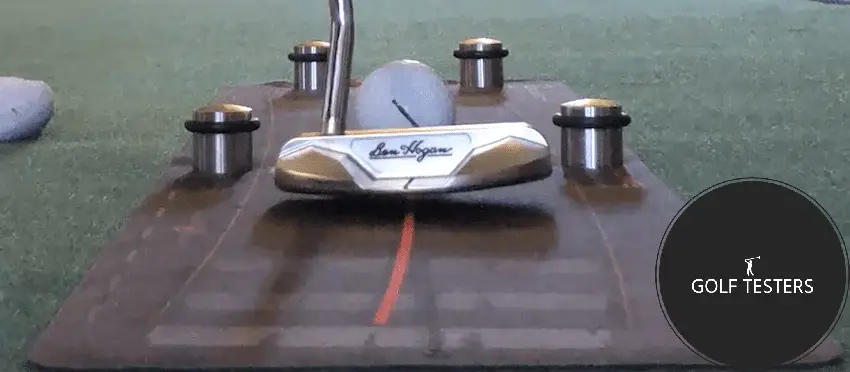
In this comprehensive guide, I will share the key insights I’ve gained from renowned experts and personal trial and error. By embracing these techniques, you’ll save valuable time and shed strokes on the course. Get ready to elevate your putting prowess and experience a remarkable transformation.
How to Putt Better In Golf?
Mastering how to grip your putter is a straightforward task and should not be tampered with once you find a comfortable grip. Avoid making adjustments unless you develop the yips or lose the use of one arm.

There isn’t a single correct method for gripping a putter. Most grips you see are either the reverse overlap grip or a variation of it. I have been using the reverse overlap grip since I started playing, but the only significant change I made was switching to a thicker putter grip about seven or eight years ago.
Here is a basic tutorial on the reverse overlap putting grip (since it’s the one I’m familiar with):
- Position your left hand (for right-handers) near the top of the putter grip, allowing the grip to align with the crease in your hand and rest just below the first knuckle of your index finger.
- Gently wrap your index finger around the left side and underneath the grip, while your thumb lightly rests on top of the grip.
- Place the lifeline of your right hand over your left thumb, which is already positioned on the top of your putter grip. Your right thumb can align with the center or slightly left of the center.
- Carefully wrap the fingers of your right hand around and underneath the grip.
That’s it! Now you should have a firm and comfortable grip on your putter.
Your putter grip is suitable as long as it helps you square the putter face to the ball along your target line, feels comfortable, and allows for consistent strokes.
Optimal Setup and Posture for Comfortable and Effective Putting

Comfort and consistency are crucial for effective putting practice. If you’re uncomfortable, you won’t be able to practice for extended periods, and if you can’t repeat your setup, you won’t be able to make putts consistently.
In my opinion, a neutral (straight) line and a neutral setup are ideal for putting. This means aligning your feet, shoulders, and hips parallel to the starting line of your putt.
Ray Floyd and Dave Stockton suggest starting with a square setup, even though you may end up slightly open. As you gain more experience, you can always make adjustments to your setup if necessary.
The truth is, experimenting with your putting technique is something everyone does throughout their golfing journey.
Special thanks to Mike Malaska for his assistance in providing these instructions:
- Position your feet shoulder-width apart, and place the golf ball just forward of the center of your stance, similar to where you would play a mid-iron shot.
- Hold your putter grip and extend your arms in front of you, allowing your elbows to bend and lightly touch your sides. Your putter should be parallel to the ground.
- Slightly bend forward from the hips and flex your knees until the putter sits flat on the ground directly behind the ball. A straight line should be from your elbows, through the putter shaft, to the ground.
- Let your hands and the putter handle hang naturally and comfortably under your shoulders while ensuring your eyes are directly over or just inside the ball.
Practice your grip and setup as often as needed until they become ingrained in your routine.
Now that your grip and setup are solid, or at least on the path to becoming solid, you can proceed confidently.
Crafting a Powerful and Dependable Putting Stroke
When it comes to putting, there are essentially two approaches:
- Putting on an arc, like the styles of Phil Mickelson and Tiger Woods. Not too shabby. This method aligns with your stroke’s natural movement, although it requires a touch more timing and hand-eye coordination.
- Putting straight back and through, as seen with Dechambeau or Steve Stricker. It’s worth noting that this technique may seem more artificial since our bodies don’t naturally move in perfectly straight lines. Nevertheless, it’s often regarded as a reliable option.
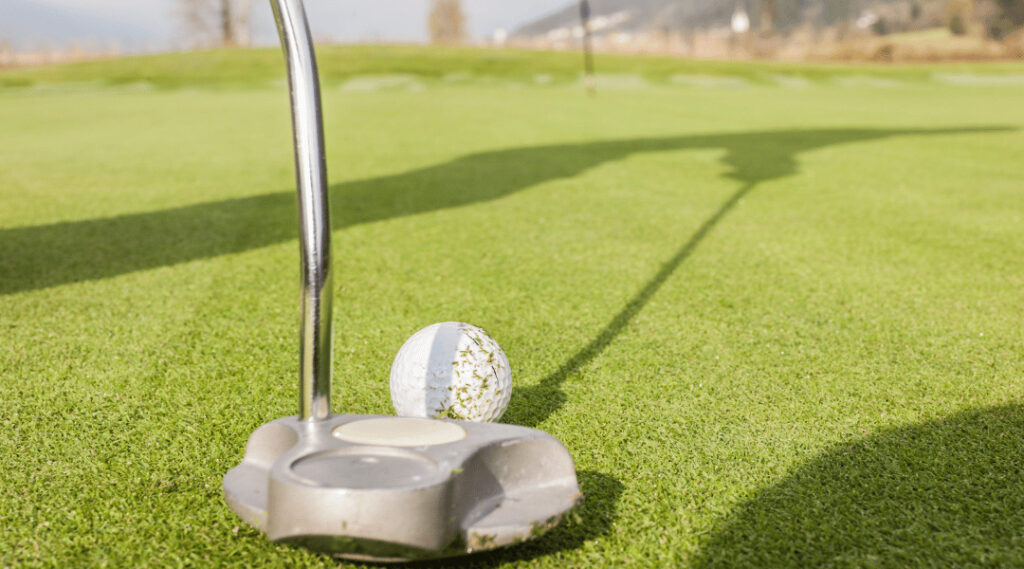
Please remember that putting straight back and forth is somewhat of an illusion. Regardless of your efforts to avoid it, your stroke will always have a slight arc. It’s just a matter of one method being more pronounced and intentional.
In my view, the best-putting stroke is the one that feels the most natural to you because it offers the greatest potential for repetition. So, I find myself somewhere between methods #1 and #2.
That said, it’s important not to force an arc into your putting stroke. Allow it to happen organically.
Discover Two Exceptional Techniques to Uncover Your Ideal Putting Stroke
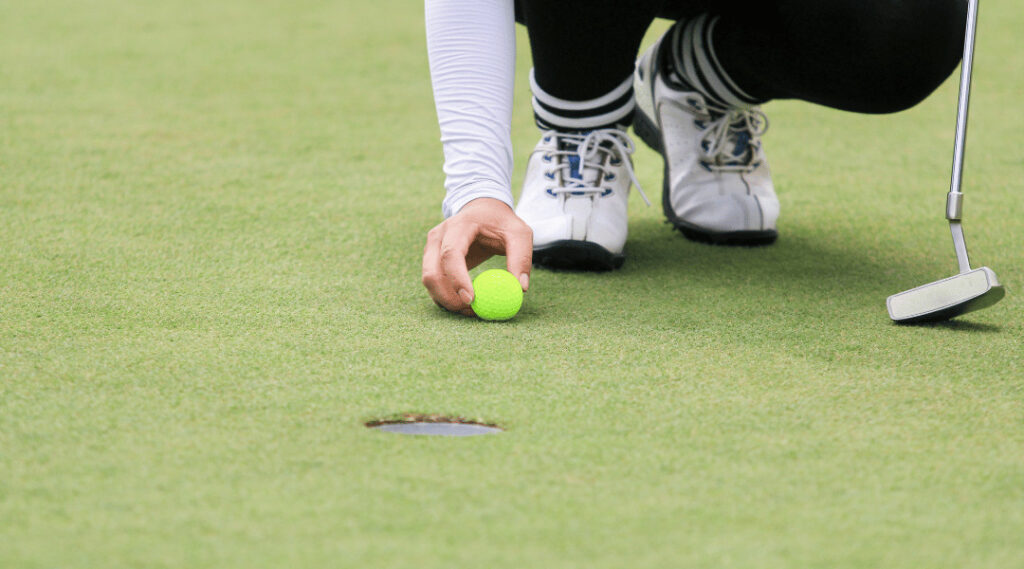
- Begin by assuming your putting setup, holding the putter without a ball:
- Lift the putter slightly off the ground, allowing it to hang freely for you to feel its weight.
- Ensure your grip is firm enough to control the putter’s movement but not overly tight. Your hands and wrists should remain calm, maintaining their hold on the putter.
- Now, initiate a back-and-forth rocking motion with your shoulders, avoiding manipulation with your hands and wrists. You will naturally observe a slight arc forming during this movement.
- Once again, assume your putting setup, this time without the putter:
- Let your arms hang naturally beneath your shoulders.
- Bring your palms together, and rock your shoulders back and forth with a relaxed demeanor. You will notice the presence of a gentle arc in this motion.
- This exercise may be easier as you won’t be manipulating the putter, allowing you to better sense the involvement of your larger muscles in powering the stroke.
When you establish the correct setup, with the putter square to your target, you increase the likelihood of striking the ball along your intended line. This is why it’s crucial to maintain quiet hands throughout the stroke.
In both of these strokes, there will be a moment when the putter is moving directly along your target line. That is precisely where the ball should be positioned.
By practicing these two putting drills, you will uncover your most effective putting stroke, which you can easily replicate.
Mastering Pace and Distance Control in Putting
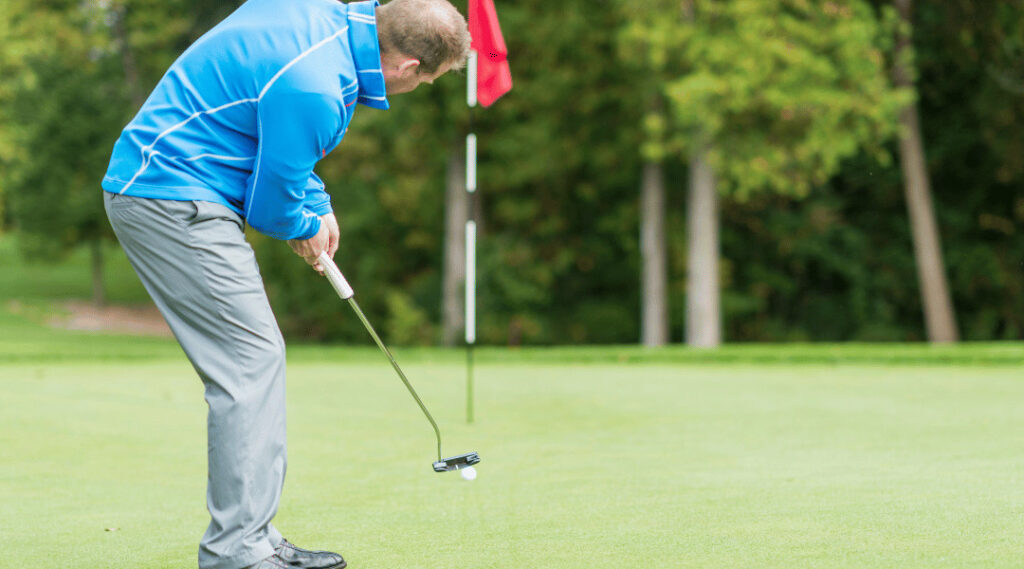
In a nutshell, the key to controlling the pace and distance of your putts lies in adjusting the length of your stroke rather than relying solely on the amount of effort exerted. Ideally, your backstroke and forward stroke should be of similar length.
Mastering the pace and distance of your putts will require dedicated time on the practice green at your local course or on a putting mat at home. There is simply no substitute for practice.
If you need access to a proper practice green, you can still work on your putting skills by practicing on your carpet. However, for an even better experience, I highly recommend investing in a high-quality golf putting mat for your home. I acquired the Wellputt mat, and it has truly transformed my putting game.
While purchasing a mat is not an absolute requirement, it allows me to practice diligently daily at home and never miss a session. The Wellputt mat has met my expectations superbly, and I wholeheartedly endorse it.
Unlocking Consistent Excellence: Becoming a Stellar Putter
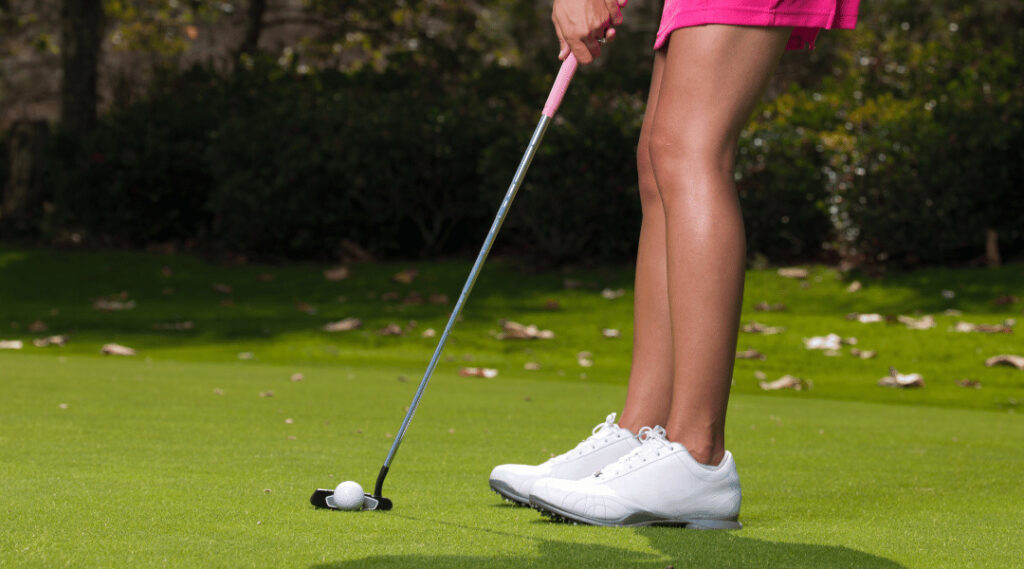
Now, let’s talk about being quiet. No, I’m not referring to keeping your mouth shut. I mean that minimizing any unnecessary movements is essential during your putting stroke.
Specifically, focus on keeping your shoulders, upper body, arms, and putter in motion while everything else remains “quiet.”
Gently rock your shoulders back and forth around a stable center point. Your body should not sway during the putting stroke, meaning it should not move away from the hole during the backstroke or towards the hole during the downstroke and follow-through.
Observe any mid to high-handicap golfer, including myself at times, and you’ll notice plenty of examples of unnecessary movements during their putting strokes.
To help maintain a quiet body during your putting, here are a few tips I’ve found helpful:
1. Avoid looking up to watch your putt roll, especially on putts within 10 feet. It’s challenging to time this movement without affecting your stroke. I’ve discovered that keeping my head down during putts yields immediate benefits whenever I remember to do so. I can almost guarantee that you will hole more putts the first time you try it, and every subsequent attempt.
- As a guideline, you could count to “2-Mississippi” before glancing up on putts over 10 feet.
- It’s still necessary to look up at some point to observe how the putt breaks at the hole if you happen to miss it.
2. Practice putting using your sand wedge. This drill teaches you to maintain a quiet body throughout your stroke.
I stumbled upon this drill earlier this year, and it has been a game-changer. When practicing putting with my sand wedge, I realized I couldn’t achieve decent contact and get the ball rolling if I wasn’t perfectly still. It has been instrumental in refining my putting technique.
Conclusion
Now that you’ve learned the essentials of putting, it’s time to delve into how to putt better in golf which will greatly enhance your ability to hole more putts during your next round.
I hope this article offers valuable resources and insightful ideas to elevate your putting game to divine levels. Of course, it will require dedication and effort, but following this approach should expedite your progress.
If you found this article helpful, please don’t hesitate to let me know. Additionally, I always appreciate it when readers share the article using one of the social buttons.

